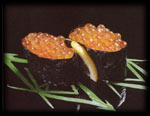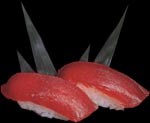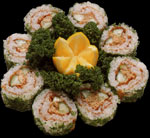SUSHI THE JAPANESE "SNACK" 1000 Years of History
What has become a Japanese culinary art with delicious flavor and colorful form, actually evolved from very meager beginnings. In the 7th century, Southeast Asians introduced the technique of pickling. The Japanese acquired this same practice which consisted of packing fish with rice. As the fish fermented the rice produced a lactic acid which in turn caused the pickling of the pressed fish. Nare-Sushi is 1300 years old and refers to the finished edible product resulting from this early method.

However, due to its lengthy process, anywhere from 2 months to a year, an altered form appears through the 15th and 16th centuries. Nama-Nare refers to this more rapid process of pickling which cut the fermentation time while including the rice as part of the meal. Ancient sushi such as, Nare-Sushi and Nama-Nare were the foundation for what later became the delightfully tasteful sushi we are familiar with today.
 Improvements through the centuries came about because of a few entrepreneurial Japanese who possessed the knack for recipe variation. The 17th century saw this delicate finger food complimented with vinegar. Matsumoto Yoshiichi of Edo (Tokyo) introduced the use of rice vinegar into the sushi rice. The vinegar was a welcome ingredient. It served to reduce the usual lengthy preparation while adding a pleasant flavor of tartness. Although the process of fermentation was shortened, the custom of aged pickling with the boxed or rolled method was continued until the 19th century. Improvements through the centuries came about because of a few entrepreneurial Japanese who possessed the knack for recipe variation. The 17th century saw this delicate finger food complimented with vinegar. Matsumoto Yoshiichi of Edo (Tokyo) introduced the use of rice vinegar into the sushi rice. The vinegar was a welcome ingredient. It served to reduce the usual lengthy preparation while adding a pleasant flavor of tartness. Although the process of fermentation was shortened, the custom of aged pickling with the boxed or rolled method was continued until the 19th century.
 In the 1820's Hanaya Yohei of Edo (Tokyo) brought to Edoites a recipe most similar to what we are served today. His morsels, which included Sashimi (fresh sliced raw fish) or seafood combined with the vinegared rice, were prepared and served for customers directly from his sushi stall. Not only did Hanaya introduce raw fish to sushi rice (Edomae-Sushi/Nigiri-Sushi), he began a tradition of serving snack food at it's freshest and fastest. His idea won immediate favor over the more time-honored sushi dishes. The portable stall was popular through WWII and was the "Fast Food" predecessor to the sushi bars of today. In the 1820's Hanaya Yohei of Edo (Tokyo) brought to Edoites a recipe most similar to what we are served today. His morsels, which included Sashimi (fresh sliced raw fish) or seafood combined with the vinegared rice, were prepared and served for customers directly from his sushi stall. Not only did Hanaya introduce raw fish to sushi rice (Edomae-Sushi/Nigiri-Sushi), he began a tradition of serving snack food at it's freshest and fastest. His idea won immediate favor over the more time-honored sushi dishes. The portable stall was popular through WWII and was the "Fast Food" predecessor to the sushi bars of today.

This healthy and delicious mouthful saw its most recent transformation in the 20th century. Sushi now appears world wide with a United States popularity increase around the late 1970's. As in art, Japanese Sushi continues to grow, change and blossom. The most common forms are: Nigiri -Sushi (hand shaped sushi), Oshi-Sushi (pressed sushi), Maki-Sushi (rolled sushi) and Chirashi-sushi (scattered sushi). The changes are not in form or preparation as much as they are in the ingredients and the atmosphere where it is served. These adventurous and tasty creations can be found in the most elegant of settings or the grocery market counter.
 The Itamae-San (expert chef) has also seen change as demand for his/her craft has grown. Years ago, one could not practice this art form without a minimum of 10 years of training and proven skill. Now, due to the growing need, restaurants will hire Sushi chefs with just a few years of learning experience. But Sushi is about culinary expertise and an Itamae-San continually strives to master his/her skill while performing for the delight of the patron and serving an array of bright colors, mouthwatering tastes and tingling sensations. Even the most timid can indulge themselves with the amazing selections of sushi. Just the history of these rolled treasures should warrant a taste … so give in and enjoy an authentic Japanese edible art form. The Itamae-San (expert chef) has also seen change as demand for his/her craft has grown. Years ago, one could not practice this art form without a minimum of 10 years of training and proven skill. Now, due to the growing need, restaurants will hire Sushi chefs with just a few years of learning experience. But Sushi is about culinary expertise and an Itamae-San continually strives to master his/her skill while performing for the delight of the patron and serving an array of bright colors, mouthwatering tastes and tingling sensations. Even the most timid can indulge themselves with the amazing selections of sushi. Just the history of these rolled treasures should warrant a taste … so give in and enjoy an authentic Japanese edible art form.
|
